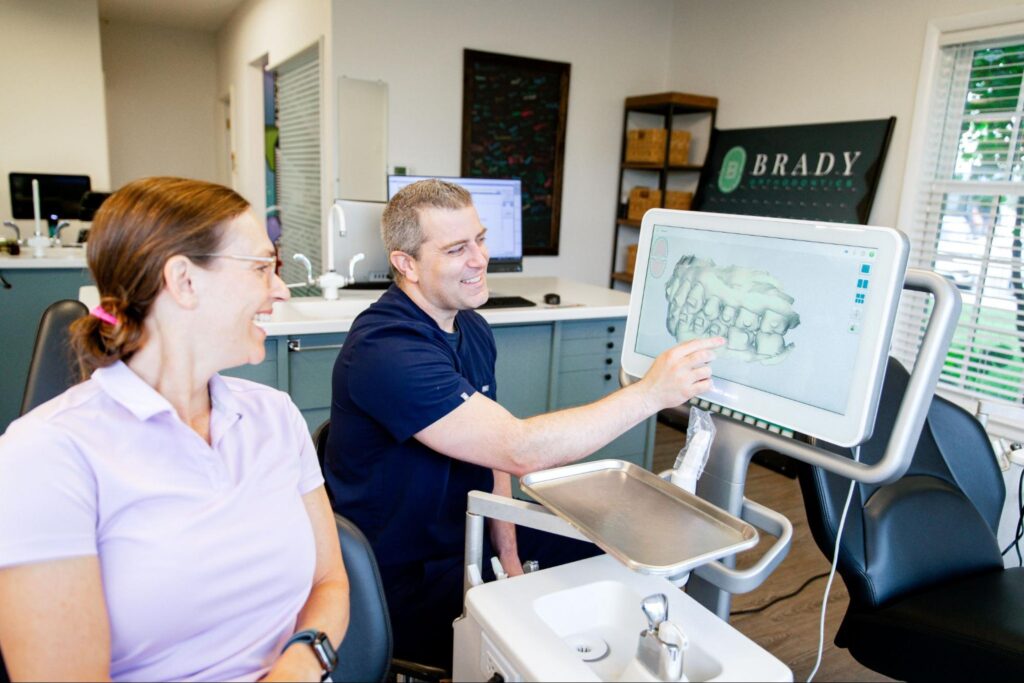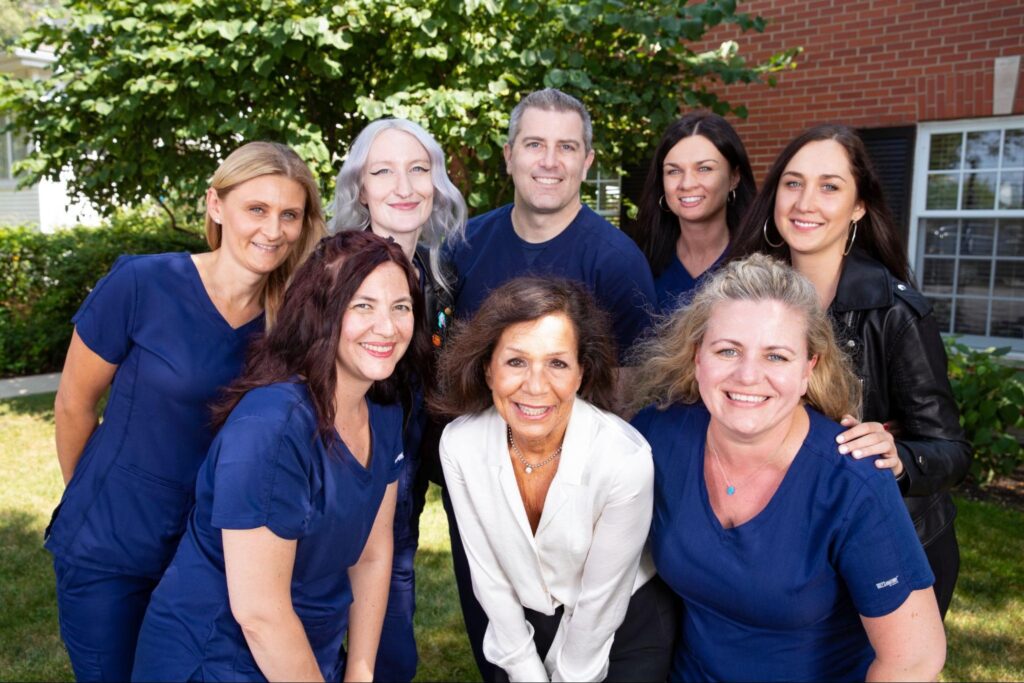At Brady Orthodontics, we proudly provide KLOwen traditional metal braces, KLOwen clear braces, InBrace hidden braces, Invisalign, and Invisalign for Teens. This variety of treatment methods allows us to treat many concerns for patients in Winnetka, Evanston, and surrounding areas. For the most part, patients with Invisalign clear aligners don’t need to change their routine to protect their oral health. However, those with metal, clear, or InBrace braces will need to adjust their daily life to prevent teeth and gum issues while wearing braces and protect their orthodontic appliances. Here’sHere’s how to do it:
Why Does Your Oral Health Matter
Wearing braces is an important step towards achieving straight teeth, but it introduces specific challenges for maintaining oral health.
The brackets and wires of traditional metal, clear, and InBrace braces essential for correcting dental alignment can trap food particles and plaque. This buildup is a prime environment for bacteria, raising the risk of tooth decay and gum disease. If you don’t thoroughly remove plaque and bacteria, it can lead to staining on the teeth around the brackets.
Your oral health needs to be in excellent shape for a pleasant orthodontic experience and the best results possible. Poor oral health can create avoidable complications, prolong treatment time, and cause cosmetic issues. By being aware of these potential problems, patients can take measures to prevent them, ensuring that their efforts to straighten their teeth don’t contribute to an unhealthy mouth or damage to the smile.

How To Improve Your Oral Hygiene Routine
One of the best ways to maintain the good condition of your teeth and gums is to modify your oral hygiene routine. Because your braces are not removable, you’ll have to work around them and be careful not to miss any nooks and crannies. If that sounds time-consuming and uninviting, don’t worry—it’s not hard to thoroughly clean your mouth with braces. It might take some practice, but you’ll be a pro in no time.
How to floss with braces
The first step of any oral hygiene routine should be to floss! Flossing with braces is essential for removing plaque and food particles that brushing alone cannot reach.
- Regardless of your type of braces, you can use waxed floss how you usually would by slipping it between the teeth and under the gums. If that is not easy, consider using a floss threader or special orthodontic floss, which simplifies the process of getting the floss behind the wires.
- After using thread floss, we highly recommend going in with a water flosser! These devices can be a handy tool for cleaning around braces of all kinds—including InBrace hidden braces! They use a stream of pulsating water to remove food particles and plaque between teeth, along the gum line, and around the braces, cleansing areas that traditional floss might miss.
- For those tight spots around brackets and between teeth, interproximal or interdental brushes are invaluable. These small brushes easily clean underneath the wires, between the brackets of braces, and between the teeth, providing a thorough clean in all areas, whether at home or on the go.
Make sure to floss at least once a day, ideally before bedtime, to ensure the health of your teeth and gums throughout your orthodontic treatment. Incorporating these tools into your daily routine can significantly enhance oral hygiene, contributing to a successful treatment outcome and enjoyable orthodontic experience.
How to brush with braces
After you floss, you have to brush!
- Start with fluoride toothpaste and a soft-bristled toothbrush that’s in prime condition. Your toothbrush can be manual or electric, though an electric toothbrush may make the process easier and provide a more thorough clean. Place your toothbrush at an angle and brush all sides of your braces. Next, brush every surface of your teeth, including the fronts, sides, and backs.
- Remember to brush your tongue, the roof of your mouth, and your cheeks to eliminate all traces of bacteria and food particles.
- Lastly, gently yet thoroughly brush your gums to prevent gum disease. Too much pressure can push the gumline down, and we don’t want that!
How to use a mouthwash with braces
Complete your routine with a good quality mouthwash to reach places that might be missed by brushing and flossing alone. Most mouthwashes come with protection against bacteria, plaque, or bad breath. If you want help figuring out which mouthwash is best for braces or your specific oral health needs, consult your trusted dentist or Dr. Brady. To receive the most benefits of using a mouthwash, you should:
- Choose an alcohol-free mouthwash.
- Use a mouthwash that has fluoride.
- Swish the rinse around your mouth according to the product’s instructions, usually for about 30 seconds, then spit it out.
Do NOT eat or drink for at least 30 minutes after rinsing with mouthwash. You must give it time to work its magic. Eating or drinking too soon might prevent the product from working correctly.
How to use whitening products with braces
When you have braces, the best way to use whitening strips or whitening toothpaste is to put them back in the box and place them in the cabinet without opening. Because your braces are not removable, the whitening agent will only reach some parts of your teeth. When your braces come off, your teeth will be different colors! Though we can fix this cosmetic mishap, it can be time-consuming and annoying, so it’s best to wait until your orthodontic experience ends.
Adjust Your Meal & Snack Routine
When you’re undergoing orthodontic treatment with braces, paying close attention to your diet and hydration is crucial for maintaining the health of your teeth and gums.
Modifying your meal and snack routines to include soft, nutritious foods that are easy to chew can significantly reduce the risk of damaging your braces and prevent the buildup of food particles and plaque. This is essential for avoiding gum disease and cavities. (Eating a braces-friendly diet also simplifies your oral hygiene routine, making it easier to keep your teeth, gums, and braces squeaky clean.)
Hydration is another key aspect of oral hygiene with braces. Drinking plenty of water throughout the day helps to rinse away food debris and plaque, reducing the risk of tooth decay and gum disease. Another way adequate water consumption helps your oral health is by aiding in saliva production. Saliva naturally cleanses the mouth and combats bacteria, so it’s crucial to the health of your teeth and gums. Opting for water over sugary drinks is a simple yet effective way to maintain oral health and ensure that your teeth and gums stay healthy during your orthodontic journey.
Don’t Forget To See Your Dentist
Maintaining regular visits to your dentist is a critical component of oral health care, especially when you have braces. These check-ups allow for professional cleaning that reaches areas difficult to clean at home, helping to prevent plaque buildup, tooth decay, and gum disease. Your dentist will also conduct a thorough examination to identify and treat any early signs of oral health issues before they become more serious.

Healthy Smiles Start Here.
At Brady Orthodontics, we’re dedicated to guiding you through your orthodontic journey with expertise and care. With convenient locations in Winnetka and Evanston, our teams are here to guarantee your treatment experience is as comfortable and effective as possible. We understand the importance of your smile and are committed to providing personalized care that meets your unique needs.
Contact Brady Orthodontics today to schedule your free consultation. Let us help achieve the smile whole family’s smile goals.
